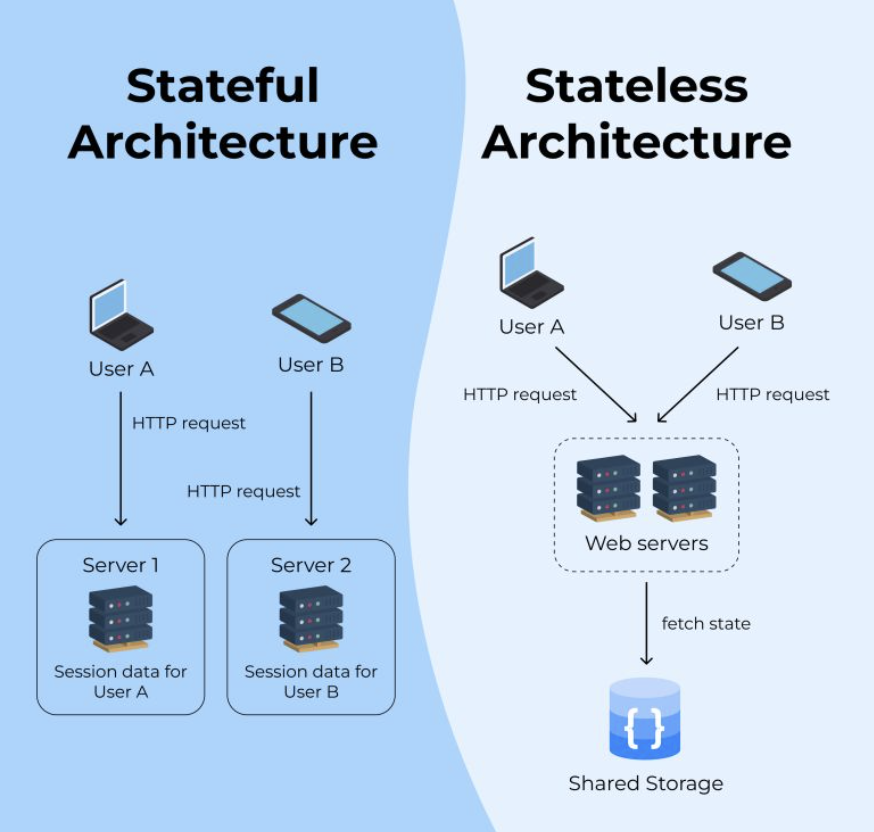Stateful vs Stateless Applications: Key Differences and Design Considerations
 Anish Ratnawat
Anish RatnawatIn the world of distributed systems and modern application architecture, understanding whether to design an application as stateful or stateless can significantly impact performance, scalability, and user experience. This blog explores these concepts, highlights their pros and cons, and provides design guidelines.

Stateful Applications
A stateful application maintains state information between requests. This means the server keeps track of the user’s interactions, storing data like session information, user preferences, and temporary data across multiple client requests.
Key Characteristics:
Session Management: State information is maintained on the server (e.g., session IDs, user data).
Resource Dependence: Requires consistent access to the same server or storage.
Failure Handling: Complex, as state restoration is necessary after crashes.
Examples:
Banking applications (maintaining session data)
Video conferencing tools (preserving connection state)
Pros:
Simplified user experience since state persistence allows continuity.
Easier to handle complex workflows where intermediate data is needed.
Cons:
Scalability challenges as servers need to retain state.
Complex failure handling, as state recovery is needed after server crashes.
Stateless Applications
Stateless applications treat each request independently. No session data is stored on the server, and each request carries all the information needed for processing.
Key Characteristics:
Independent Requests: Every request is self-contained.
Scalable Architecture: Easy to scale by adding more servers.
Fault Tolerance: No state recovery is needed if a server crashes.
Use Cases:
RESTful APIs and microservices.
Content delivery networks (CDNs).
Serverless computing platforms.
Pros and Cons:
| Pros | Cons |
| Easy horizontal scaling. | Repetitive data transmission. |
| Simplified fault tolerance. | Complex workflows need extra handling. |
Stateful vs Stateless: Side-by-Side Comparison
| Feature | Stateful Applications | Stateless Applications |
| State Management | Maintains state across sessions. | No state is maintained. |
| Scalability | Challenging due to session affinity. | Easy horizontal scaling. |
| Failure Handling | Requires state restoration. | No state recovery needed. |
| Performance | Can be slower due to overhead. | Generally faster and simpler. |
Design Considerations
When choosing between stateful and stateless architecture, consider the following factors:
Scalability Needs:
Stateless systems are ideal for applications that require scaling across multiple servers.User Experience:
Stateful applications provide smoother, continuous experiences, which are essential for certain workflows.Failure Handling:
Stateless applications are easier to manage in case of server failures.Resource Management:
Stateful applications may require more resources to manage sessions and state.
Hybrid Approach:
Many modern systems adopt a hybrid approach, where critical user interactions are stateful (e.g., login sessions), while the rest of the interactions remain stateless.
Conclusion
Choosing between stateful and stateless architectures depends on your application's requirements. Stateless systems offer simplicity and scalability, making them a popular choice for cloud-native applications. However, stateful systems are essential for delivering rich, interactive user experiences where context matters. Understanding these trade-offs is key to designing robust, scalable, and efficient distributed systems.
Tip for Software Engineers: For large-scale systems, consider using stateless microservices with a stateful data store to balance performance and user experience.
Are you working on designing stateful or stateless systems? Share your thoughts and experiences in the comments below!
Subscribe to my newsletter
Read articles from Anish Ratnawat directly inside your inbox. Subscribe to the newsletter, and don't miss out.
Written by
